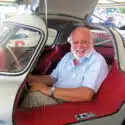Doug Nye: ‘Are readers as sick of hearing ‘running P3’, ‘in quali’ or ‘Turn 5’ as I am?’
Some modern racing jargon is simply illogical
Shall I do it? I’ve thought about it for quite a while. It is annoying. Yes, it’s Grumpy Old Man time. Are any readers as heartily sick of hearing “Box – box – box!”, or “He’s running P3”, or “There’s a chance of P1”, or “in quali” pronounced ‘kwally’, or “At Turn 5”, or “In Turn 1”…as I am?
Changing times – changing generations of fans and enthusiasts (who are of course often different animals), but changing jargon – well – just stokes one’s pressure pump.
The first time I covered a race at the Nürburgring, back in the 1960s, was also my first visit to Germany. Having been raised on the standard ’50s diet of war movies, usually featuring Jack Hawkins and James Mason or John Mills and Anthony Steel, I was fascinated to see real policemen indeed wearing long grey-green leather coats and to hear such guttural PA pronouncements as “Alle Fahrzeuge im Fahrerlager!” Or “Nummer sieben ist in Der Box!”. Fahrerlager – paddock, or at least the lager part, conjured up all kinds of PoW movie memories. Box – the pit to a properly brought-up racing-mad Brit.
So, box – pit – both three-letter single-syllable words. Both distinctive, emphatic, with plosive initials – neither likely to be confused in context with another word in, for example, a radio call. So why would the former now have so comprehensively replaced the latter in daily motor racing jargon?
Beats me…
I find it even more difficult to accept ‘P3’ or ‘P1’ as a description of position or result within a race. Why use a two-syllable form when in these cases ‘third’ or ‘first’ are utterly specific, quick, crisp and even simpler to say?
‘Quali’ is just a naff-sounding abbreviation, and admittedly trips off the tongue more smoothly than ‘qualifying’ – half as many syllables – but then we get to corner designation, and the thought that the Silverstone Grand Prix circuit’s Copse Corner has now become to drivers, engineers and PR people alike Turn 9 – while Stowe is Turn 15…. Blimey O’Reilly, an entire battalion of track-owning BRDC members would surely be bouncing off the rev limiter at that.
Of course the corner naming by Turn number was a transatlantic import, based largely upon American board-Indianapolis-style speedway habit. Indy was built with its four more or less identical 90-degree corners entitled Turn 1, 2 etc from unarguable logic. The speedways’ 19th century predecessors –largely fairground trotting track and horse-race courses had established that habit.
British tradition was rather different. Our horse racing traditions had already prevailed for centuries, largely on estates owned by the landed gentry. Course corners inherited the estate names from local geography. On Continental Europe the great road race circuits on which the sport developed after 1902 actually ran through towns and villages. Their names were adopted simply to describe approximate location, the circuits typically being so long there would otherwise be hundreds of twists and turns to christen, so most corners were anonymous until something conferred certain notoriety.
“It’s such a shame our great drivers today talk turns by numbers”
Pre-war in the UK motor racing centred upon the unique Brooklands Motor Course. Its banked Outer Circuit had, in effect, only three ‘turns’, each long and – in linear terms other than their frost-vulnerable surface – gentle. But they were named, the Members’ Banking – close to the exclusive Club members’ viewing area, the Byfleet Banking after the adjacent village, and then there was the gentle kink descriptively-named The Fork.
The supreme Isle of Man TT course followed European practice of using pre-existing place names because of its length, like Ballacraine, Greeba or Crosby, with Quarterbridge, Union Mills and The Bungalow, etc derived from relevant adjacent features. When Donington Park came along as a proper road-style mainland circuit in 1933, its corners took names from the Park estate’s features like Coppice (farm), Red Gate and Holly Wood, local personality McLean’s, and from the nearby village of Melbourne.
Sadly – as racing progressed – fatalities could endow the crash site with the unfortunate victim’s name. After 1927 Birkin’s Bend at Rhencullen on the TT course commemorated motorcyclist Archie Birkin (younger brother of ‘Bentley Boy’ Sir Henry). The Ascari Curve at Monza became a prime example after the first double-World Champion’s demise there in 1955. And of course the huff-and-puff publicists and promoters had already done their bit to attract paying spectators to dramatic locations – the 1914 Grand Prix course at Lyons having its challenging Virage de la Mort (where to my knowledge no racing driver nor mechanic actually died), and the US Grand Prize course in Santa Monica had its Death Curve…
At least we still hear current commentators sometimes use corner names not numbers –especially the more euphonious Italian tags such as Rivazza, Tamburello or Acque Minerali at Imola, the Lesmo or Parabolica – the ‘Diabolica’ to many Brits – at Monza.
But numbering turns is computer technology, newspeak logical to engineers, and it’s a language computers can digest, so they stuff ‘the romance’. Regardless, it’s such a shame our great drivers today talk turns by number. Sadly I can’t see that ever being confined to where it belongs. In a box.
Doug Nye is the UK’s leading motor racing historian and has been writing authoritatively about the sport since the 1960s

